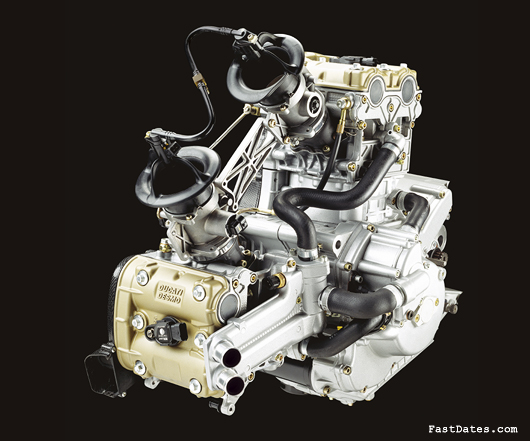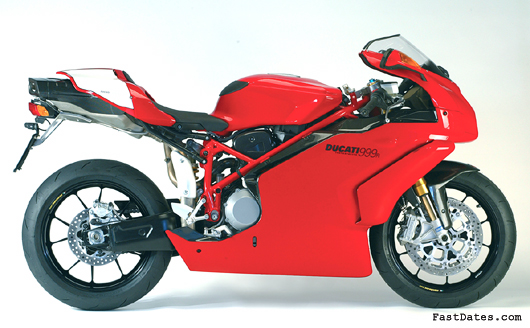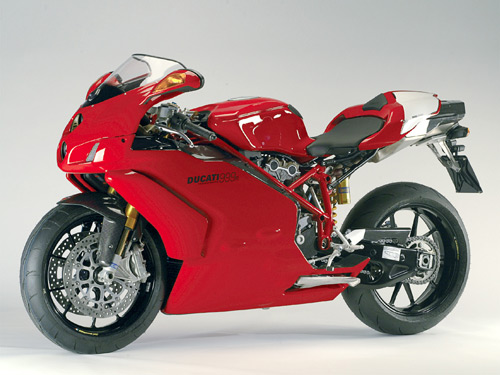| 
Ducati 999R 05 Homolagation Superbike
July
8th 2004 - An evolution of power, aerodynamics and style,
for a dream Ducati which is more competitive and powerful than
ever. Based on the motorcycle representing Ducati in this year's
American Superbike Championship (AMA), the 999R has been significantly
upgraded for the American market.
A new front fairing, new rear swing arm and suspension, a major
upgrade to 150 horsepower for the engine are all intended to reinforce
the bike's Superbike status.
AMA technical
regulations allow fewer modifications to the engine than the international
Superbike regulations so Ducati, which returned to the AMA championship
this year, has produced an engine with technical characteristics
that are much closer to those of the racing version. The new 999R
is yet another step forward in Ducati tradition, which has always
been characterised by the manufacture of series production bikes
similar to their race versions not only in styling, but also in
technical features.
Previous
editions of the R model Ducati Suberbikes were produced in limited
500 bike production runs each season to homologate them for Superbike
racing. Ducati has not announced any limited production numbers
for the revised 2005 model 999R, so we assume demand is now high
enough for the $30,000 racer that it will now be included on the
regular production line at the Bologna factory.

The
Engine
The basic dimensions of the Testastretta engine used on the new
999R remain the same as those of the previous version. The cylinder
bore is thus still 104 mm and the stroke stays at 58.8 mm, for
a total displacement of 999 cc. However, the maximum power and
torque have been greatly increased. Compared to the previous model's
102 kW (139 hp) at 10000 rpm, the new engine produces 110 kW (150
hp) at 9750 rpm. The torque itself has been increased from 108
Nm (11 kgm) at 8000 rpm, to 116.7 Nm (11.9 kgm) at 8000 rpm.
In order to fully understand what these figures mean for the new
999R, it is instructive to take a look at the variation in MEP
(Mean Effective Pressure). This value is an important parameter
in rating the engine, and measures the work the engine is capable
of doing throughout a complete cycle (i.e. through all four phases).
The Testastretta engine of the 999R ë04 has a MEP at maximum
torque of 13.6 bar. The new model, on the other hand, exceeds
14 bar, a limit which no series production Ducati engine has ever
reached before. At maximum power, the MEP value for the 999R model
year 2004 Testastretta engine is 12.3 bar, while on the MY ë05,
at the same power output, the value increases to 13.5 bar. It
is clear that in the two cases under consideration, the volumetric
and thermodynamic performance of the new engine (in other words,
its capacity to take in and burn the fuel/air mixture) are significantly
improved, thanks to the substantial technical upgrades to the
cylinder assemblies. In this context, it is worth noting that
the air flow rate in the intake ducts (permeability) has been
increased by 22.8%, while the exhaust duct flow rate has increased
by 5.8%. The overall optimisation of the engine is confirmed by
the fact that the improved maximum power value is now achieved
at an engine speed which is lower by 250 rpm than the corresponding
speed of the Testastretta engine mounted on the previous 999R
model. The engine speed limiter is set to 11000 rpm.
New
Cylinder Assemblies
In order to improve performance, the cylinder heads and pistons
have been completely redesigned and should really be regarded
as completely new components, designed specifically for racing.
The pistons are forged and constructed from an aluminium alloy
with high mechanical specifications to ensure outstanding geometrical
stability during the wide thermal excursions to which they are
subject. The variation of the geometrical specification, as well
as the new shape of the combustion cavity in the head, has resulted
in a compression ratio of 12.45 +/- 0.5 :1 (slightly greater than
that of the previous R version of the Testastretta engine, which
was rated at 12.3:1).
The valve
seats are deeper due to the increased valve lifts. The heads have
undergone a radical fluid-dynamics redesign. In order to make
it possible to use larger diameter valves, their centre distances
have been increased which means that the routing and dimensions
of the intake and exhaust ducts have also had to be modified.
Still in comparison to the previous 999R Testastretta, the squish
surfaces have been increased to improve the turbulent flow in
the combustion chamber, resulting in significantly increased combustion
efficiency. To summarise, the improvements to the new 999R engineís
cylinders have greatly increased the engine's ability to "breathe"
as well as its combustion output. The result of these modifications
is evident from the significant improvements in overall performance
of the road version, which means with absolutely standard exhaust
system, silencer and intake system.
The engine
also meets established emissions standards. It should be noted
that metal gaskets are not used between the head and cylinder
of each assembly, but rather special seal rings (called Wills
seals) around the perimeter of the combustion chamber. The large
cylinder bore makes this necessary if a perfect seal is to be
achieved. The overall redesign of the cylinder head has also made
it necessary to respecify the cooling ducts. The valve covers
are now in magnesium for lower weight.
Timing
Belts
To limit the temperature of the timing belts and not only to keep
down the overall weight of the vehicle, Ducati's competition bikes
have never been fitted with protective timing belt covers. However
these units are necessary to protect the belts when the bike runs
onto the gravel at the side of the track, and this year the Ducati
R&D department has installed timing belt covers with dynamic
cooling on the 999R, as already done on the 749R. The horizontal
cylinder timing belt cover has an intake with a small sponge filter
which attaches to the front fairing. The air is taken in at this
point, circulates in the timing belt housing and exits via a NACA
opening in the top of the vertical cylinder timing system cover.The
engine speed and phase timing wheel
A new element is the timing wheel on the timing drive shaft gear
which, along with an magnetic induction sensor, generates the
signal used by the ECU to detect the engine speed and operational
phase. The timing gear teeth are not used, as on previous Testastretta
engines, but instead the system uses a timing wheel with bumps
machined onto the outer circumference of the gear face itself.
This results in a cleaner electrical signal from the induction
sensor.
Engine Casings and Low Sump
The
engine casings are sand-cast, to highlight the exclusivity of
the product. The dimensions of the units are no different from
those used on the previous 999R Testastretta engine. The studbolts
which mount the cylinder assemblies are located in such a way
as to make it possible to mount such large bore cylinders (104
mm). The lubrication circuit retains the "low sump",
a fundamental feature of race engines, as this allows the oil
pump to always draw the lubricant in all vehicle positions (e.g.
bike cranked over, under harsh acceleration or with the front
wheel in the air).
Crankshaft
The
components in the engine casing of the Testastretta mounted on
the new model 999R have not undergone significant modification
compared to those used in the previous version, with the exception
of the crankshaft. This component now has a new configuration.
It is almost completely machined, to optimise its form. It has
thus been possible to obtain a weight reduction while maintaining
a perfectly balanced crank layout. The lubrication ducts inside
the crank pin are also completely new: they no longer run horizontally,
but diagonally while directly communicating with the duct along
the two main journals. In this way it has been possible to reduce
(from three to one) the number of plugs required to close off
the surface borings necessary for machining the ducts themselves.
The conrod manufactured by Pankl is in titanium to reduce the
weight of the crank linkages.
Valves
The Testastretta engine of the new 999R uses titanium valves,
both on the intake and exhaust. The weight saving is considerable,
especially if we consider the strong accelerations imposed by
the high engine speed. The valve diameter is 42 mm on the intake
with valve lift of 13 mm, and 34 mm on the exhaust with lift of
11.5 mm. On the previous 999R's engine the intake valve diameter
was 40 mm with 11.71 mm lift and the exhaust valve diameter was
33 mm with 10.5 mm lift. The use of titanium has obliged Ducati
to use special valves seats and guides. The timing diagram has
not been substantially changed relative to the previous 999R engine,
although the cams are of a completely new shape. The intake valves
now open by 21∞ before the TDC, compared with a previous
value of 16∞, and close 53∞ after BDC relative to
the previous 60∞. The exhaust valves open at 60∞ before
BDC as before, while they close 20∞ after TDC compared to
a previous value of 18∞. The inclination of the intake and
exhaust valves on the new 999R is no different from that of the
old version, at 12∞ and 13∞ respectively off the cylinder-head
axis. In line with Superbike race engines, the retaining system
on the closing register valve stem has been changed. This register
is acted on by the desmodromic timing rocker to close the valve,
and its thickness determines the play between its surface and
the fork-shaped ends of the rocker itself, with which it contacts.
This play must be adjusted with great precision, since it greatly
affects the mechanical stress on the timing components, as the
valve returns to its seat. It also affects the timing diagram,
which must be close to the nominal diagram. The closing register
retainer system normally used on series Ducati engines exploits
the action of two half-rings seated in a cavity machined near
to the upper end of the valve stem. These two half-rings engage
the register. However, this system has evident limits on a race
engine which is often run at its top engine speed. In these conditions
the half-rings are severely stressed and tend to deform plastically
(they are crushed) and hence do not guarantee a constant play
between the register and the rocker. For this reason the Testastretta
engine of the 999R uses two titanium half-cones which encircle
the valve stem. They have a circular section bump on their inner
surface which engages with the groove machined near to the end
of the valve stem itself. This groove is however not as deep as
that used for the half-ring system. Furthermore, the two half-cones,
when the steel closing register is pressing against them, grip
the valve stem under friction, thus considerably reducing the
stresses around the groove. This enables the valve stems of the
new 999R to be not 7 mm (as used on the other Testastretta engines)
but 6 mm, resulting in a further weight saving. It is also worth
noting that the half-cones, since they perfectly couple with the
register, are not subject to deformation even though they are
highly stressed. This means that the valve closure play remains
constant for a longer time when the engine is running. As already
indicated, the valve centre distance has been increased over that
on the previous 999R's Testastretta engine. It has thus been possible
to use parts with a larger diameter head. Each valve has been
moved outwards (orthogonally to the ducts) by 0.75 mm, for an
overall increase in stem centre distance of 1.5 mm (the new centre
distances are 43 mm between the two exhaust valves and 46.8 mm
between the two intake valves). The valve seats also have a higher
position relative to those of the previous engine. It follows
that they protrude more into the head combustion cavity, which
has been completely redesigned along with the larger squish surfaces.
The volume of the cavity is thus less than that in the heads of
the previous model engine. As already indicated, the consequent
increase in the compression ratio has been limited by reducing
the height of the piston head.
The
Intake and Exhaust Systems
Nothing has changed in the new 999R's intake and exhaust systems
compared to the previous version. There is a single, large volume
silencer, and the manifolds have no intersection points. In particular,
the difference in length between the front cylinder manifold compared
to the shorter rear cylinder manifold has been compensated for
with a number of differing cross-sections (varying from 45 to
55 mm for the front unit, constant at 45 mm for the rear unit),
so as to ensure identical fluid-dynamic behaviour of both exhaust
systems. Furthermore, the rear cylinder manifold penetrates into
the silencer. The Testastretta engine used on the road version
of the Ducati 999R is equipped with catalytic converters. Each
cylinder assembly has a dedicated three-way catalytic converter.
The one on the front cylinder is fitted about halfway along its
exhaust manifold, while the rear cylinder unit is integrated into
the initial section of the silencer. The airbox has a large volume
(12.5 dm3 ) and is not closed off by the lower surface of the
fuel tank. The ducts which lead the intake air from the dynamic
scoops on the front fairing to the airbox are equipped with a
Helmholtz resonator to reduce intake noise without penalising
engine performance. The RH duct is integral to the coolant tank.
Engine
Type Twin-cylinder L-configuration,
Desmodromic timing,
4 valves per cylinder,
liquid cooled
Engine bore 104 mm
Stroke 58.8 mm
Total displacement 999 cm3
Maximum power 150 HP @ 9750 rpm
Maximum torque 11.9 kgm @ 8000 rpm
Compression ratio 12.45:1
Intake valve diameter 42 mm
Intake valve lift 13 mm
Exhaust valve diameter 34 mm
Exhaust valve lift 11.5 mm
Intake/exhaust valve material titanium
Valve angle (inclusive) 25∞
Timing diagram (with 1 mm valve play)
Intake:
Opening before TDC 21∞
Closing after BDC 53∞
Exhaust:
Opening before BDC 60∞
Closing after TDC 20∞
Conrod centre distance 124 mm
Conrod material titanium
Primary transmission ratio 32/59
Gear ratios First 15/37; Second 17/30; Third 20/28; Fourth 22/26;
Fifth 23/24; Sixth 24/23
Final transmission ratio 15/36
Clutch type Multi-disk, dry sump
Oil pump Gear type
Lubrication circuit capacity 3.8 l
Generator 480 Watt
Electronic ignition/injection ECU IAW 5M2
Ignition stick coil, in sparkplug seat
Injectors one per cylinder, IWPR2, 12-jet
Theft alarm Immobilizer integral to engine ECU

Click for
a bigger view.
Frame
and Two-Member Swingarm
There have been no substantial modifications to the frame used
on the previous 999R, which is still of the trestle type, constructed
in high strength steel tubing. The suspended engine is a bearing
component and contributes to the torsional rigidity of the assembly.
The cross-member supporting the starter motor on the series production
bike is removable to enable use of a larger capacity fuel tank,
as provided by the championship regulations. The footplates can
be moved to two different positions. A great deal of attention
has been paid to weight distribution and the location of each
single component, which plays a fundamental role in transferring
the loads experienced during dynamic riding (braking, acceleration,
curves). Indeed, the individual components must be as close together
as possible to contain the arms on which the masses act and as
a result the momentum generated, so as to ensure highly responsive
handling of the motorcycle. This is yet another reason why Ducati
has followed the principle of maximum integration in designing
the bike, with the aim of achieving a high density of components
in a reduced volume. The swing arm is identical to that of the
motorcycle which will be raced in the Superbike championships.
The fulcrum support is an aluminium casting, while each arm is
composed of two sheet profiles pressed and welded together to
achieve a box cross-section. The left hand member also includes
a lower reinforcing member. The wheel shaft is supported by two
forged units welded to the ends of the arms. These components
are equipped with a failure screw specified to a specific breaking
strain which thus ensures that the wheelbase cannot be lengthened
under stress. The wheelbase is the same as that of the 999 and
the distance between the wheel centre and swing arm fulcrum is
490 mm +/ñ 12.5 mm (the variability is enabled by the chain
tensioning slot). If the failure screw is removed and the rear
wheel is set to its furthest back position, the swing arm centre
distance is 512.5 mm. In this case the motorcycle's wheelbase
is such as to counteract sudden variations in position during
dynamic braking and acceleration (thus reducing rear wheel grip
failure under braking and counteracting front wheel lift under
acceleration while guaranteeing sufficient drive).
Forged
Aluminium Alloy Wheels
The rear and front wheel rims are made of forged aluminium, a
technology which enables weight reduction while maintaining resistance
to mechanical stress. Compared to castings, it is possible to
use thinner sections since the material is distributed evenly
throughout the component. The lower weight of the rims not only
reduces the suspended masses (which significantly improves suspension
performance), but also greatly reduces the gyroscope effect and
improves the handling of the bike at high speeds (the bike is
more agile when entering curves). Forging is done with a hydraulic
press using special dies with a load of thousands of tons. The
material thus becomes plastic while maintaining its original molecular
structure and hence guaranteeing the mechanical properties of
the finished part, even with greatly reduced sections. Casting,
on the other hand, requires the metal to be liquid, which alters
its molecular structure, and the material is poured into a mould
for cooling. There is thus no certainty that the material perfectly
fills all the mould cavities. To ensure that the mechanical strength
of the part is adequate, castings must therefore be thicker and
heavier than forged parts.
The
Front Forks and New Rear Shock Absorber
The front forks and the new rear shock absorberThe callipers of
the front brakes are radially mounted to special mounts on a new
÷hlins fork, the legs of which are surfaced in TiN for
improved sliding. The two legs have modified, smaller diameter
springs and the spring guide is now in plastic rather than metal.
This reduces the formation of detritus which tends to pollute
the oil. The lower section of the cartridge rod is fitted with
a counterspring, which counteracts the main spring at maximum
extension during violent acceleration. The usual cam system allows
the steering head angle to be adjusted and thus also the trail
(91 ñ 97 mm). The rear shock absorber has been improved
by making rebound damper adjustment completely independent (with
a one-way valve), so that the rebound damper no longer acts on
the compression damper.
New
Front Fairing
The headlamp mount and the new mirror mounts are now in magnesium
alloy. The fairings with scoops, front fairing between the two
side fairings, the front mudguard, chain guard, silencer heat
shield and windshield fairing are all in carbon fibre. The tail
section, on the other hand, is in techno-polymer. The forms of
the fairings are identical to those on the 999R, while the windshield
fairing has changed and now lacks the upper flow guides while
featuring a plexiglass windshield with a new shape. Overall, apart
from improved aerodynamics, the new system provides better rider
protection at high speed (when crouched over the fuel tank) and
better visibility of the instrumentation (the black rubber surround
of the plexiglass windshield does not block the rider's view of
the instrument panel warning lights).

Electronics
More sophisticated engine ECU
The new 999R's engine ECU uses the same sensors and actuators
as the preceding version. However, the ECU itself has been changed
to the IAW 5M2 unit, again produced by Magneti Marelli, and is
now capable of handling a larger number of inputs and outputs,
to allow for future expansion of the regulation strategies. The
injectors (IWPR2), again from Magneti Marelli, are identical to
those used on the race bike and have a higher flow rate for the
same opening time. They have 12 atomisation jets and tighter,
more constant flow tolerance. The form of the spray and the very
small droplet size make an essential contribution to the outstanding
performance of the engine. The spark plugs are surface discharge
units, Champion RG59V. They do not have the traditional protruding
ground electrode, so that the spark no longer follows a fixed
route, but is rather generated around the central electrode in
the most favourable direction. This greatly reduces the probability
of misfires and hence failure of mixture combustion in the chamber.
The coils are of the stick type and are therefore located in the
spark plug seat on each head. The electrical connection is no
longer directly mounted to the body to avoid potential damage
due to vibration.
The
CAN bus ñ a more streamlined electrical system
The use of a CAN (Controller Area Network) network with two main
nodes: instrument panel and engine ECU (Magneti Marelli IAW 5M2),
has greatly simplified the electrical system, with a significant
weight reduction. To limit the number of cable bundles the designers
have eliminated duplications in the number of sensors on the motorcycle.
Their signals must therefore be shared by the various on-board
processors. This can only be done by sending the sensor's signal
to the closest controller, which is then charged with sending
it on to the network so that it can be used by the processors
which need it. The CAN bus network is composed of only two cables
carrying trains of digital signals, each of which carries precise,
perfectly decodable information. The nodes of the network (the
instrument panel and the engine ECU), have special hardware which
enables them to recognise which signal trains concern them and
must therefore be processed by their processors. This technology
enables a considerable simplification of the electrical system,
which in some sections is composed of no more than the double
CAN bus cable.
Chassis
Specifications
Frame steel tubing,
trestle-type
Trail 91 - 97 mm
Steering head angle 23°30’ – 24°30’
Wheelbase 1420 mm
Front suspension stroke 120 mm
Front fork leg diameter 43 mm
Rear suspension stroke 71 mm
Rear wheel travel 128 mm
Front rims and tyres rim MT 3.50x17” tyre 120/70 17
Rear rims and tyres rim MT 5.50x17” tyre 190/50 17
Minimum ground clearance 125 mm Seat height 780 mm
Rider footplate height adjustable to 387 mm and 410 mm
Seat height
780 mm
Maximum width 730 mm
Handlebar width 671 mm
Maximum length 2095 mm
Steering angle 28° 30’ right/left
Dry weight (without fluids and battery) 181 kg
Front brake disks (diameter) 320 mm
Rear brake disk (diameter) 240 mm
Radial four piston front brake callipers 34 mm (piston diameter)
Two piston rear brake calliper 34 mm (piston diameter)
Front brake master cylinder piston 18 mm (piston diameter
Rear brake master cylinder piston 11 mm (piston diameter)
Go
to: Ducati 999R05 Information
Page 1 • Test Page 2
• Test Page 3 •
999F05
Return
to Ducati
Index • New
Bike Index • Pit
Lane News |
